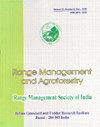了解三种不同盐生草在盐和钠胁迫下的生理和分子适应
IF 0.8
4区 农林科学
Q3 AGRONOMY
引用次数: 0
摘要
对3种盐生植物进行了生理生化分析,探讨了它们的耐受性和植物修复潜力。根据气体交换特性、抗氧化系统、土壤盐度(ECe 30 ~ 50 dS/m)和酸度(pH 9.5 ~ 10)条件下的生物量产量对盐生植物尾盘藻、边缘孢子藻和褐藻进行了分类。在pH为9.5的盐胁迫条件下,fusca和S. marginatus的生物量略高,而U. setulosa的生物量在盐胁迫下有所增加。在盐碱条件下,黑穗兰叶片钾含量降低幅度较小,K+/Na+比值较高。在ECe ~ 50 dS - m-1时,fusca的净光合作用下降幅度最大(28.55%),而在pH ~ 10.0时,S. marginatus的净光合作用下降幅度最小(13.73%)。相比之下,木犀草的气孔导度和蒸腾速率高于云杉和边缘木犀草。在最高的pH和盐度下,3种盐生植物的APX、SOD、GR和POX酶的抗氧化活性均增加。3种盐生植物中MnSOD、NHX1和FuSOS1基因的定量表达随盐胁迫的增加而增加。根据这些指标,将这些盐生植物分为耐盐和耐碱两类。本文章由计算机程序翻译,如有差异,请以英文原文为准。
Understanding physiological and molecular adaptations of three diverse halophytic grasses under saline and sodic stresses
Physiological and biochemical analyses of three halophytes were conducted to explore their tolerance and phytoremediation potential. The halophytes Urochondra setulosa, Sporobolus marginatus and Leptochloa fusca were categorised based on gas exchange attributes, antioxidant system, biomass production under soil salinity (ECe 30-50 dS/m) and sodicity (pH 9.5-10). L. fusca and S. marginatus produced slightly higher biomass under the sodic condition of pH 9.5, while in U. setulosa, it increased under salinity stress. Under sodic conditions, L. fusca showed less reduction in potassium content and maintained a higher K+/Na+ ratio in their leaf tissues. A maximum decrease in net photosynthesis was observed in L. fusca (28.55%) at ECe ~ 50 dS m-1 while minimum in S. marginatus (13.73%) at pH ~ 10.0. Comparatively, U. setulosa showed higher stomatal conductance and transpiration rate than L. fusca and S. marginatus. At the highest pH and salinity, the antioxidant activities of enzymes APX, SOD, GR and POX increased in all three halophytes. Quantitative expression of MnSOD, NHX1 and FuSOS1 genes in all three halophytes increased with salt stresses. Based on these indicators, these halophytes were categorised as salt-tolerant or alkaline-stress-tolerant.
求助全文
通过发布文献求助,成功后即可免费获取论文全文。
去求助
来源期刊

Range Management and Agroforestry
AGRONOMY-
CiteScore
1.50
自引率
62.50%
发文量
25
审稿时长
>12 weeks
期刊介绍:
The Society has been established with the following objectives:
1. To advance the cause of research activity in all aspects of rangelands and to encourage and promote the studies on rangeland, wasteland ecosystems and agroforestry.
2. To provide facilities for seminars and conferences to rangeland researchers, development workers and farmers and to encourage close cooperation with organizations having related aims and interests.
3. To disseminate the knowledge of scientific agriculture and technology for forage and rangeland production, improvement and management.
 求助内容:
求助内容: 应助结果提醒方式:
应助结果提醒方式:


